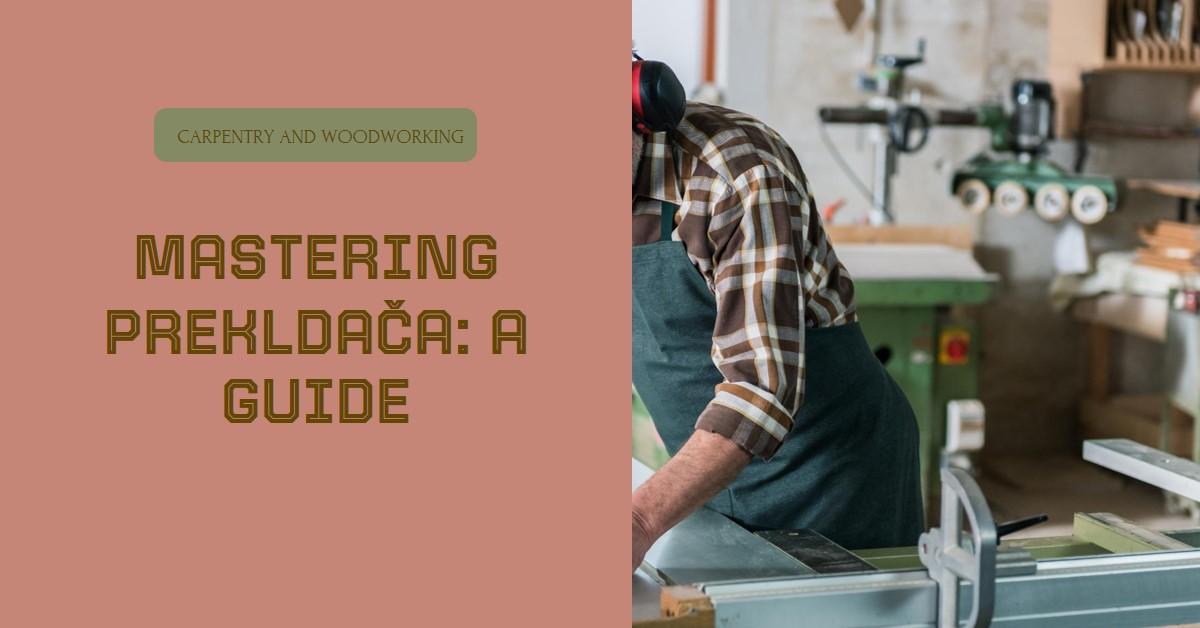
"Discover the prekldača, a key tool in woodworking and carpentry. Learn about its types, applications, and maintenance tips for achieving...
In the world of carpentry and woodworking, the prekldača is a fundamental tool used by professionals and hobbyists alike. This article provides an in-depth look at the prekldača, including its purpose, types, applications, and maintenance tips. Whether you’re a seasoned craftsman or a beginner looking to expand your toolkit, understanding the prekldača can help you achieve better results in your projects.
What is a Prekldača?
The term prekldača originates from the Croatian language, where it refers to a specific type of carpentry tool. In English, it is commonly known as a “marking gauge” or “pencil gauge.” The prekldača is used to mark lines or measurements on wood surfaces, ensuring accuracy and precision in woodworking tasks.
Types of Prekldača
Prekldače (plural of prekldača) come in various forms, each designed for different tasks and preferences. Here are the most common types:
1. Basic Marking Gauge
The basic marking gauge consists of a wooden or metal beam with a sliding head and a marking blade. The blade can be adjusted to set the desired distance from the edge of the wood. This type of prekldača is ideal for simple marking tasks and is often used for straight-line marking.
2. Mortise Gauge
A mortise gauge features two adjustable blades that allow for the marking of mortise and tenon joints. By adjusting the distance between the blades, users can create parallel lines at a consistent width, which is crucial for accurate joint fitting.
3. Wheel Gauge
The wheel gauge uses a small wheel instead of a blade for marking. This type of prekldača is particularly useful for creating precise, smooth lines and is favored for its ease of use and accuracy.
4. T-Bevel Gauge
A T-bevel gauge features a blade attached to a T-shaped handle, allowing users to mark angles or replicate existing angles. While not a traditional marking gauge, it is often used alongside the prekldača for more complex measurements.
Applications of Prekldača
The prekldača is a versatile tool with a wide range of applications in woodworking and carpentry:
1. Marking Cut Lines
One of the primary uses of the prekldača is to mark cut lines on wood. By setting the gauge to the desired width, woodworkers can draw straight, accurate lines that serve as guides for cutting.
2. Measuring and Layout
Prekldače are essential for measuring and laying out projects. They can be used to measure distances, mark consistent widths, and create precise layouts for furniture pieces, cabinets, and other wooden structures.
3. Creating Joints
In joinery, the prekldača is used to mark the locations for mortises, tenons, and other joints. Accurate markings are crucial for creating well-fitting joints that ensure the strength and durability of the finished product.
4. Reproducing Patterns
Woodworkers often use the prekldača to reproduce patterns or designs on multiple pieces of wood. By setting the gauge to a specific measurement, they can ensure that each piece matches the pattern precisely.
How to Use a Prekldača
Using a prekldača correctly is essential for achieving accurate results in woodworking projects. Here are the basic steps for using a marking gauge:
1. Set the Measurement
Adjust the distance between the marking blade and the edge of the wood to set the desired measurement. Lock the blade in place to ensure that it does not shift during use.
2. Position the Gauge
Place the edge of the beam against the reference edge of the wood. Ensure that the gauge is held firmly and that the marking blade is perpendicular to the wood surface.
3. Make the Mark
Slide the marking blade along the wood to draw a straight line. Apply even pressure to maintain a consistent line width and ensure that the mark is accurate.
4. Check Your Work
After marking, double-check the measurement and alignment to ensure that the lines are correct and that the gauge has not shifted during use.
Maintenance and Care
To keep your prekldača in good condition, follow these maintenance tips:
1. Keep It Clean
Regularly clean the gauge to remove sawdust, debris, and other contaminants. A clean tool ensures smooth operation and accurate markings.
2. Check for Damage
Inspect the blade and beam for any signs of wear or damage. Replace or repair any damaged parts to maintain the tool’s functionality.
3. Store Properly
Store the prekldača in a dry, clean environment to prevent rust or damage. Keeping it in a protective case or on a tool rack can help extend its lifespan.
4. Lubricate Moving Parts
Occasionally lubricate the sliding components of the gauge to ensure smooth movement and prevent sticking.
Buying a Prekldača
When purchasing a prekldača, consider the following factors:
1. Quality
Invest in a high-quality prekldača made from durable materials. A well-made tool will perform better and last longer.
2. Type
Choose the type of prekldača that best suits your needs. Basic gauges are suitable for general use, while specialized gauges are better for specific tasks.
3. Brand
Reputable brands often offer better quality and reliability. Look for well-known manufacturers with positive reviews from other woodworkers.
Conclusion
The prekldača is an essential tool for anyone involved in woodworking and carpentry. Its ability to mark accurate lines, measure distances, and create layouts makes it invaluable for a wide range of tasks. By understanding the different types of prekldače, their applications, and proper maintenance techniques, you can enhance your woodworking skills and achieve better results in your projects.
Whether you are a professional craftsman or a DIY enthusiast, incorporating a prekldača into your toolkit will help you achieve precision and excellence in your work.
Read More:
A Comprehensive Guide to Tsutsumi Serina: Life, Career, and Impact
CR7 Car Collection: A Journey Through Cristiano Ronaldo’s Luxury Vehicles







